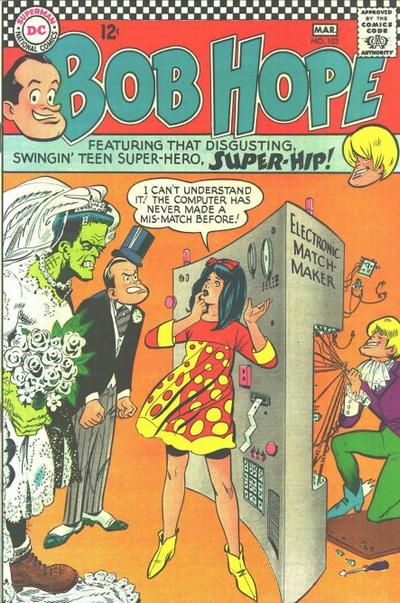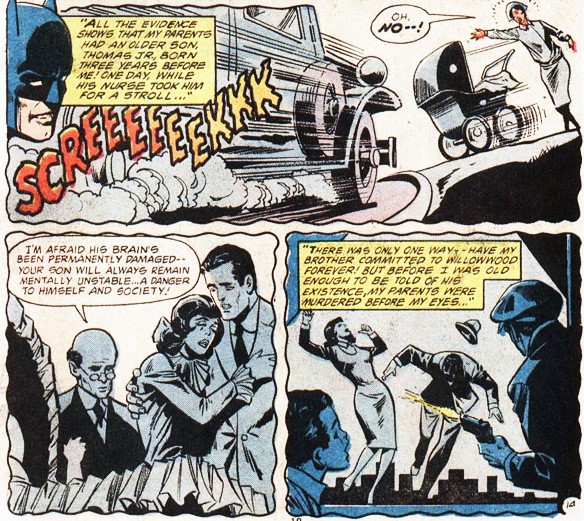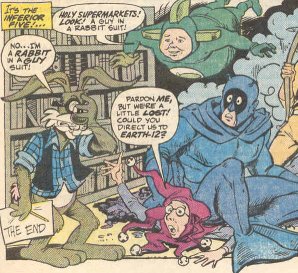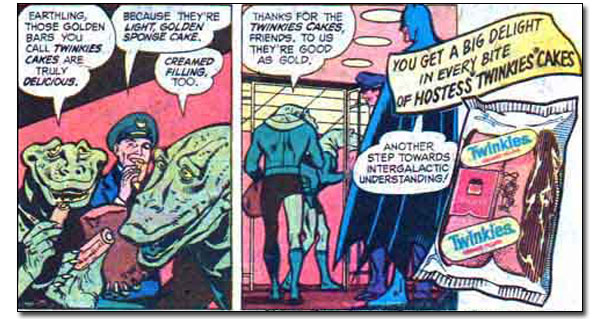

By the late 1970s there were a handful of Silver Age DC stories that just seemed out-of-continuity no matter what. They just didn’t fit into Batman’s primary Earth (i.e. the DCU’s pre-Crisis Earth-1), violated characterization, had obvious continuity errors, or were just plain strange (even for Silver Age comics). Many of these stories in question were written by Bob Haney and E Nelson Bridwell and edited by Murray Boltinoff and Bob Rozakis. Thus, these out-of-synch tales retroactively became assigned to Earth-B. The assignment of the letter B came from the fact there were so many B names creatively-involved in the non-synchronous tales—Bridwell, Boltinoff, and two Bobs (three if you count Bob Hope)! Further reasoning for assigning the letter B was that many of these tales also took place in The Brave & The Bold. While it is rumored that Myron Gruenwald and Mark Gruenwald originally came up with the idea for Earth-B, the concept was first mentioned in a letters column by Rozakis in the 1970s. Creators Mark Waid and Lou Mougin cemented the concept of Earth-B in 1986’s OFFICIAL CRISIS ON INFINITE EARTHS CROSSOVER INDEX. However, the Crossover Index was co-published by Independent Comics Group (ICG) and was therefore considered only quasi-official at the time. Thus, several contradictions arose within.
One of the bigger contradictions in direct relation to Batman revolves around the appearance of Thomas Wayne Jr, Bruce’s older brother. (Scott Snyder’s Lincoln March is based on this Silver Age character.) Mougin and Waid, in the Crossover Index, state clearly that the 1974 appearances of Thomas Wayne Jr (in World’s Finest Comics #223 and World’s Finest Comics #227) are definitive occurrences on Earth-B. Now, while that is set in stone, the confusion lies in the fact that this doesn’t necessarily mean that Thomas Wayne Jr doesn’t also exist on Earth-1. Because of this, many wikis and online Silver Age synopses include Thomas Wayne Jr as part of Earth-1 canon as well. There are precedents. Scholars Mikel Midnight and Douglas Ethington regard the Golden Age Robin origin story in Batman #32, Part 2 as contradicting the Golden Age Robin origin story in Detective Comics #38. They place Batman #32, Part 2 solely on Earth-B. Likewise, 1994’s Batman: The Last Angel occurs on the Earth-B timeline (as its final future tale) and simultaneously on the Modern Age timeline. However, the Thomas Wayne Jr stories also contradict DC Comics Presents #24 by failing to acknowledge Deadman’s prior actions. Therefore, it does seem like WFC #223 and WFC #227 are non-canon on Earth-1, making them definitively Earth-B stories.

But the contradictions were further amplified (or cleaned-up, depending on your point-of-view) in 2005, when the Crossover Index was updated and republished as part of Crisis on Infinite Earths: The Absolute Edition. Because the Earth-B timeline—a timeline comprised entirely of contradictory stories—itself contained contradictions, comics historian/researcher John Wells decided that Earth-B could be even further broken down into parts. As co-author of the “Compendium” section of The Absolute Edition, Wells created Earth-32, a place to hold all of the stories that definitely couldn’t work on Earth-1, but which also seemed to be on shaky ground on Earth-B. (Wells used the number 32 for his new Earth, citing that many of the stories that weren’t jibing with the rest of the Earth-B chronology could be traced back to both 1964’s Green Lantern #32 and 1945’s Batman #32.)
With Earth-B missing a chunk of its previous material (which had now migrated to Earth-32), Wells realized that Earth-B was a hatchet-job and really looked like something unrecognizable. Thus, he took all the material that wasn’t re-assigned to Earth-32 and listed it as a part of another new Earth: Earth-12. (Earth-12 was first mentioned in 1986’s Oz-Wonderland War—a three issue series that saw Captain Carrot and the Zoo Crew join forces with the inhabitants of L Frank Baum’s Oz and Lewis Carroll’s Wonderland to fight Ruggeddo the Nome King. Eat your heart out, Alan Moore! The Inferior Five make a brief appearance in Oz, citing that they are looking for Earth-12. This has led some to speculate that the Inferior Five stories occur on Earth-12 (and therefore Earth-B as well).

Because of Wells’ 2005 updates, some sources list Earth-B as an “unofficial Earth,” merely an amalgamation of the two “official Earths,” Earth-32 and Earth-12. But this is a chicken-or-the-egg scenario. Earth-B was first, then Earth-32, then Earth-12. One could endlessly continue this process and get nowhere fast. Wells himself is nearly guilty of wandering into this desert. While most of the Batman toy tie-ins, food product mini-comics, and cereal box mail-aways occur on Earth-B/Earth-32/Earth-12, Wells—in The Absolute Edition—notes specifically that the Hostess Snack Cake free comics and in-comic Hostess advertisements featuring Batman from the 1970s and 1980s all take place on a separate “Earth-Hostess.” Earth-Hostess! See what I mean? The best way to look at it is by accepting that Earth-B, Earth-32, and Earth-12 (and Earth-Hostess) each exist. Earth-B merely exists as a separate timeline that combines all of Earth-12 and Earth-32.

Another interesting fun fact about Earth-B’s Adventures of Bob Hope series. Some of its elements were canon on Earth-1, most notably the debut and existence of Bob Hope’s amazingly ridiculous nephew Tadwallader Jutefruce, who moonlights as the superhero called Super-Hip.
Below is a Batman of Earth-B timeline (of my own creation). Many of these items, as explained above, also go on Wells’ Earth-32 or Earth-12. Note that the meat-and-potatoes (i.e. stuff in-between the items on the list below) reflects the Silver Age Earth-1 timeline. Basically, this means that if I were making a full Earth-B timeline, I would copy and past most of Earth-1’s chronology into it.
–Batman #32 (also canon on Golden Age pre-Crisis Earth-2 timeline)
–Adventures of Jerry Lewis #97
–Swing with Scooter #5
–Adventures of Bob Hope #103
–The Brave & The Bold #84
–The Brave & The Bold #90
–The Brave & The Bold #96
–The Brave & The Bold #99
–The Brave & The Bold #108
–World’s Finest Comics #223
–World’s Finest Comics #227
–The Brave & The Bold #117
–Batman Power Records Comic #PR-27
–Batman Power Records Comic #PR-30
–The Brave & The Bold #124 (introduction of Earth-PRIME B)
–Amazing World of DC Comics #11
–The Brave & The Bold #131
–The Brave & The Bold Special
–The Brave & The Bold #146
–Aquateers Meet the Super Friends (1979, this likely goes on the Super Friends’ Earth 1-A too)
–Batman: The Peril of the Penguin (1979, Post Fruity & Cocoa Pebbles box mini-comic giveaway)
–Super Heroes: Prisoners of the Stars (1979, Post Fruity & Cocoa Pebbles box mini-comic giveaway)
–Batman: The Joker’s Last Laugh (1980, Post Super Sugar Crisps box mini-comic giveaway)
–Super Heroes: The Secret of the Sinister Lighthouse (1980, Post Super Sugar Crisps box mini-comic giveaway)
–The Brave & The Bold #162
–The Brave & The Bold #167
–Batman: Belt ‘Em For Safety (1981, Mini-Foldout comic for The National Highway Traffic Safety Administration)
–Super Powers Collection #2 (1983, Kenner toy tie-in)
–Super Powers Collection #5-9 (1983, Kenner toy tie-in)
–Super Powers Collection #11 (1983, Kenner toy tie-in)
–DC Challenge #1-12 (1985-1986)
–Viewmaster Mini Comics: The Joker’s Wild (1993, based on “5-way Revenge”)
–Justice League America vs. Amazo (1993, Kellogg’s Cinnamon Mini Buns mini-comic)
–Batman: The Last Angel (1994, also canon on Modern Age Earth-0)

The Earth-B items on the list above only include issues that feature Earth-B Batman. As already stated, the Earth-B timeline is modeled off of the Silver Age Earth-1, so a version of pretty much every Silver Age DC character would also live on Earth-B. Other inhabitants, however, are unique to Earth-B. Besides the comic versions of Bob Hope, Dean Martin, and Jerry Lewis, unique inhabitants of Earth-B include The Green Team, Prez Rickard, The Inferior Five, The Freedom Brigade, Santa Claus, Rudolph the Red-Nosed Reindeer, Plastic Man (from Arnold Drake and Gil Kane’s Plastic Man Vol. 2 ), Scooter and his gang (from Swing with Scooter), and The Super Friends (from the comics only).
Of course, the past is the past. The Silver Age ended with The Crisis on Infinite Earths in 1986. And Earth-B/Earth-12/Earth-32 all disappeared into the great white ether as well. The Modern Age (and later New 52/New Age) would give us a new Earth-12—home to the Batman Beyond DCAU characters—and a new Earth-32—home to the Elseworlds-styled Justice Titans.
A major research source for this article comes from Mikel Midnight’s “Cosmology Compendium: Earth-B Timeline” (2005), which in turn filtered information via writers Douglas Ethington and John Wells. Historian John McDonagh (seemingly via Wells and writer Mike Tiefenbacher) also proves a worthy research source in the comments section of a 2006 “Comic Book Urban Legends Revealed” blog post by scholar Brian Cronin.
Editor’s Note: Collin Colsher is a comic historian writing on comics as well as laying out the continuity of The Batman Universe as they should be in the timeline of events as part of The Real Batman Chronology Project. Check out all of his other work at his site.
